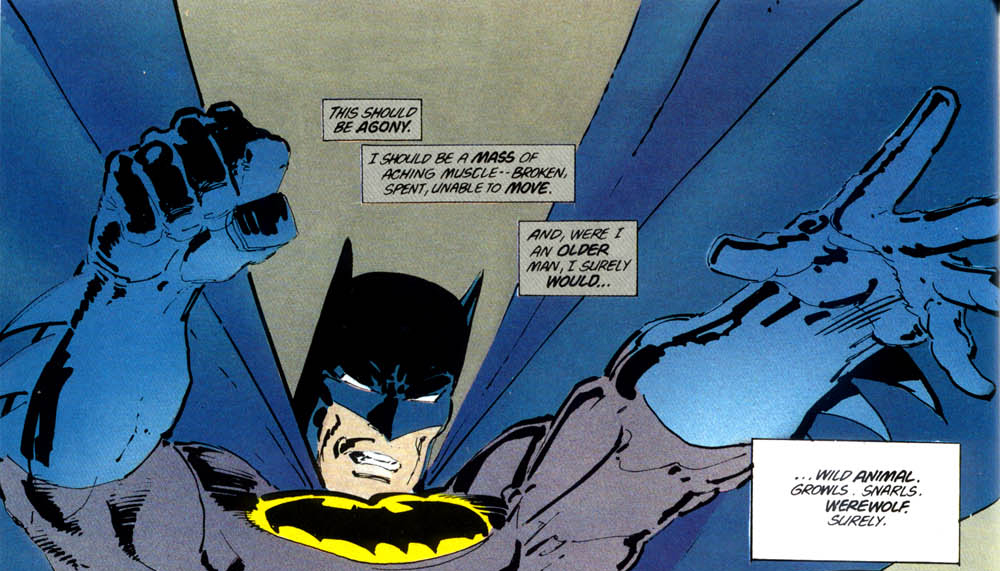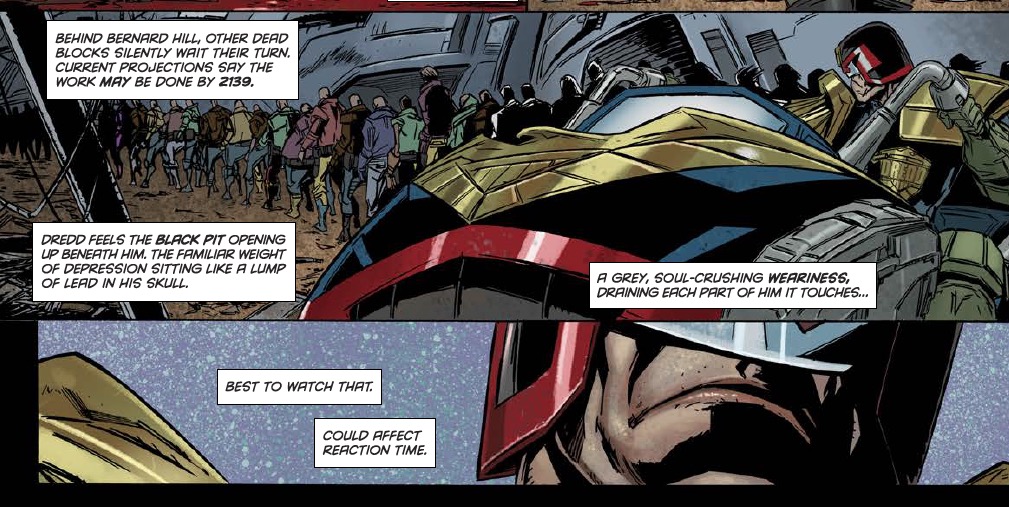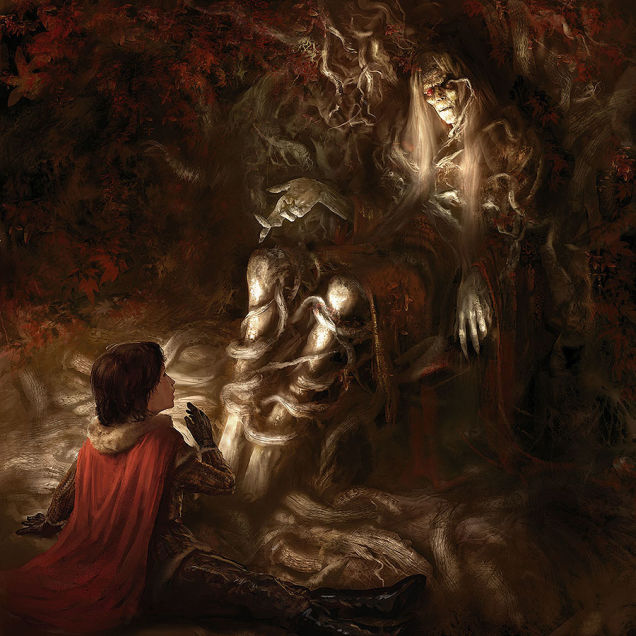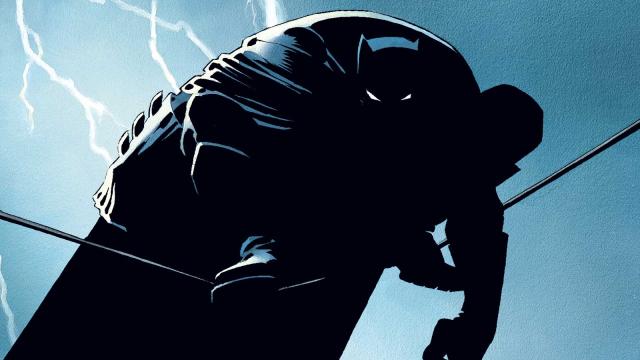About 30 years ago, both superhero comics and fantasy novels went through a startling narrative transformation. In comics, narrative captions replaced thought balloons. In books, authors started writing “tight” third person narrative, instead of “omniscient” or first person. Why did this happen?
The shifting perspective
If you read a comic book from prior to the mid-1980s, you’ll see cloud-shaped word balloons attached by white dots to characters’ heads. These “thought balloons” let you see what a given character was thinking, at any given moment.
But comic-book writers like Alan Moore and Frank Miller started changing this standard, through comics where the character’s internal monologue was conveyed through rectangular captions instead of fluffy balloons. The most iconic example could be The Dark Knight Returns, whose long, brooding Bat-monologue was parodied in a lot of late-1980s comics like Teenage Mutant Ninja Turtles.

Around the same time, in prose fiction, “tight” third person narration became much more standard. This is narration where all the characters are referred to in third-person pronouns, but we see through the eyes (and into the mind) of one character in particular. This replaced “omniscient” third person, in which multiple viewpoints could be represented, and to some extent it also supplanted first-person narration.
Douglas Wolk (Reading Comics) says that Moore and Miller definitely led by example in comics: “Moore and Miller didn’t really use thought balloons much in the ’80s, and as they went, others followed; editors discouraged them because they weren’t “cinematic” enough; not using them could also be a way to seal off someone’s thoughts from the reader, or show a lack of interiority.”
But Jess Nevins (Encyclopedia of Pulp Heroes) says that although most 1970s comics were packed with thought balloons, some 1970s creators did help start the trend: notably, Gerry Conway’s “War Journal” captions in the Punisher comics, and Bob Kanigher’s captions in some of DC’s war comics. But it wasn’t until the 1980s when Moore and Miller popularised this.
And Wolk notes that the Judge Dredd comics started using third-person (not first-person) captions in the 1980s, which allowed for a lot of scene-setting and atmosphere, that also dipped into Dredd’s mind from time to time. This has become an influential feature of the Dredd comics — Wolk offers this recent example, from Al Ewing:

Meanwhile, “tight” third person has been around forever as a narrative device, notes Walter Jon Williams (This Is Not A Game) — Dickens, Tolstoy, Faulkner and Bradbury use it, among others. And the 1960s experimentation with stream-of-consciousness writing was “tight third of a sort,” says Williams. But it’s become much more prevalent in genre fiction, in particular, in the past few decades. This started in the 1970s and really started to catch on in the 1980s.
What caused the shift to “tight” third person narration? Williams theorizes this happened “when the genre became expansive enough to include lots of character reveals as well as plot reveals. And by ‘expansive,’ I mean that more or less literally, because the 60,000-word limit on novels had to be broken.”
In the 1990s, writers like Robert Jordan with The Wheel of Time and George R.R. Martin, with A Song of Ice and Fire, popularised the idea of sprawling novels in which each chapter followed a different character’s point of view exclusively, allowing for a rich cast of people, each with their own inner life. (In Tuf Voyaging, Martin’s 1986 fix-up novel, he lapses into omniscient POV from time to time, even telling us that Tuf did not see a monster growing in a vat behind him at one point. So Martin’s devotion to third-person limited began in earnest after the mid-1980s.)
By the 1990s, the term “head-hopping” had entered the lexicon of workshops and critique groups, as a syndrome where the narrative perspective shifts willy-nilly from one person to another, without a clear demarcation such as a section break.

Getting into a character’s head
Williams says third person “limited” (or “tight” third person) is about getting a closer focus on a single character’s emotional landscape:
The reason you go to a tight third is because you want to focus on the character’s feelings and sensations, and for some reason you don’t want to use first person. (There might be too many characters to use first person on all of them — or there might be some whose inner processes you don’t want to reveal.)
Feelings meant a lot to Ray Bradbury. Montag in “Fahrenheit” is nothing but one long anguished shriek.
But my guess is that feelings and sensations aren’t important in a lot of SF. It’s a literature of ideas, supposedly, but more rightly a literature of problems. The important thing isn’t what the character feels, but whether he analyses and solves the problem correctly. If you’re an economical writer — – and pulp writers had to be economical or they couldn’t sell — – you can’t afford to include a lot of anguish or self-analysis or existential doubt, because that wouldn’t get you to the end of your story…
Ditto the mystery novel. The classic English mystery novel is third person, but not too close to the detective, because if you get into the detective’s head and show his thought processes, you’ll get to the reveal before you want to. You want to preserve the mystery so that the detective can do his big revelation in front of an audience.
I use tight third in most of my works, but then most of my works have only a single point-of-view character. And when I decided to do it that way, I did it because I was interested in the character and wanted to reveal him/her to the reader. If the character isn’t a primary focus, but a substitute for the readers’ POV, you don’t need to bring the reader in so tight.
And meanwhile, Nevins says that 1970s comics were full of angst and strong emotions, even with their reliance on thought balloons. But a maturing, more experienced audience in the 1980s probably seized on the rise of captions as a more sophisticated narrative technique.
“We were definitely reacting to the content of Miller and Moore’s work, but I feel like we knew we could get that angst in other places, and that it was the skill of presentation and the new techniques which attracted us,” says Nevins. At the same time, he admits that the rise of thought captions, with an extended monologue, might have offered more of an opportunity to “get more caught up in the drama and more viscerally sympathize with the characters.”

Two theories about the rise of captions and limited perspective
My personal theory about the shift to “internal monologue” captions and “third person limited” narration is that in both cases, it allows you to get closer to a character’s emotions and psyche.
A first-person narrator can’t really rant too much, before the reader starts getting annoyed. And an omniscient narrator might not necessarily spend a few pages describing a single character’s angry train of thought without panning out at some point. Meanwhile, there’s a limit to how many angsty “I am the night” speeches you can put into fluffy clouds. If you really want to see inside a character’s brooding soul, you need a tighter focus or a set of captions that belong to that character alone.
(With balloons, in theory you can show what a few characters are thinking at any given moment, whereas dueling thought captions are rarer.)
This dovetails with Williams’ theory that “tight” third person allows for more emotional, as opposed to plot, reveals.
But Daniel Abraham, author of The Dagger and the Coin and one half of James S.A. Corey, offers a different theory: It was the rise of television. The people who were reading books and comics in the 1980s had grown up watching television, and wanted something that more closely mirrored that experience.
Says Abraham:
John Gardner talks about psychic distance as a term for how far the reader is from the action of the story, and close third is in the range that a television camera produces. And remember, we’re not talking about the overall scope of the work being limited to a character — in Game of Thrones, George does a cast of thousands, each of them in close third. It’s how the psychic distance is managed *within each scene* that makes it like TV. The camera creates the same distance whether it’s on Jon Snow or Daenerys. I’m rereading A Tale of Two Cities right now, and Dickens is shifting from in close to someone’s internal life and back out to an unnamed narrator’s commentary on history within the same scene. That’s cool, but it’s not familiar and TV isn’t a good tool to recreate that experience.
There was a shift in the vocabulary of our imagination — and with it our reading protocols — that TV carried with it. We’re comfortable at camera-length because we’ve practiced it sometimes for hours every day for most of our lives. And the preference for third person isn’t the only place you see it; look at transitions within chapters too. Lord of the Rings has these beautiful, swooping transitions where Tolkien pulls away from the action to a much larger scope and then back down into another scene distant in space or time. I skip a space. Which is to say, I do transitions on the cut, like TV or movies. It’s easy, it’s effective, and the readers already know how to take it in stride. I’d guess (though I haven’t really looked) that we also have more stories now that start in media res than we did in the 50s, but I may be wrong about that.
This dovetails with what Wolk said about thought captions seeming more “cinematic” than thought balloons. In the 1980s, both comics and genre novels were trying to approximate more closely the experience of watching TV and movies.
Of course, neither TV nor movies can tell you exactly what a character is thinking or feeling — but they can use music to convey emotion, says Abraham. And both omniscient third person and first person narration involve breaking the fourth wall, letting a narrator comment on the action in a way that’s hard to achieve in live action without obtrusive voiceovers.

Comments